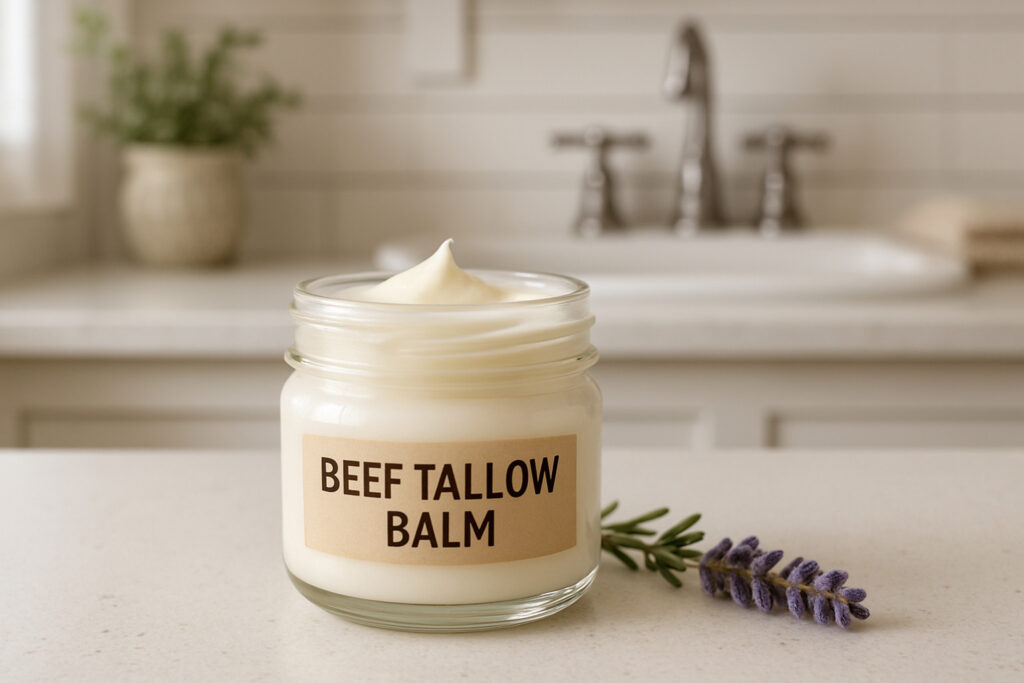Why Beef Tallow for Skin Is Having a Skincare Moment
Beef tallow for skin has exploded across social media, with over 50,000 TikTok posts showcasing this rendered cow fat as the latest clean beauty trend. But this isn’t actually new – it’s an ancestral practice that cultures worldwide have used for centuries to protect and heal skin.
Quick Answer: What You Need to Know About Beef Tallow for Skin
- What it is: Rendered fat from cattle that’s solid at room temperature
- Key benefits: Deep hydration, skin barrier repair, rich in vitamins A, D, E, K
- Best for: Very dry skin, eczema, mature skin seeking natural anti-aging
- Caution: May clog pores for acne-prone skin; comedogenic rating of 2-3
- Quality matters: Choose grass-fed, properly rendered tallow for safety
The appeal is simple: tallow’s fatty acid profile closely mimics human sebum, making it highly compatible with your skin’s natural oils. It contains beneficial compounds like conjugated linoleic acid (CLA) and fat-soluble vitamins that plant oils simply can’t match.
Research shows tallow-based emulsions improved moisture levels in people with atopic dermatitis and psoriasis. A 2024 scoping review found that while human studies are limited, tallow’s biocompatibility with skin shows promise for therapeutic use.
However, not all tallow is created equal. Quality sourcing, proper rendering, and understanding your skin type are crucial before jumping on this trend.
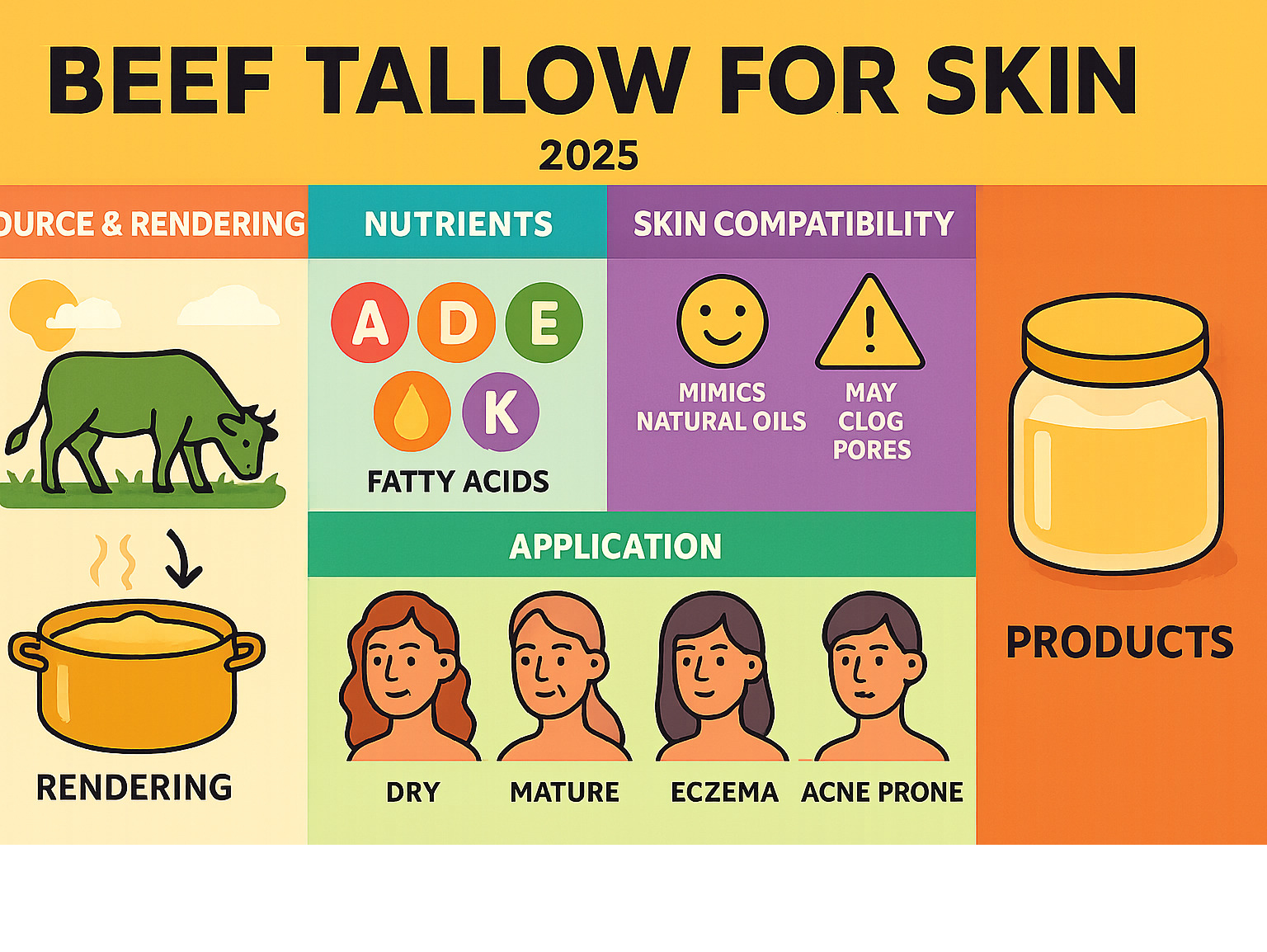
Find more about beef tallow for skin:
What Is Beef Tallow and How Is It Rendered?
Beef tallow for skin starts with something pretty humble – the hard fat around cattle kidneys and loins called suet. This isn’t your average cooking fat. When properly rendered, suet transforms into a creamy white, wax-like substance that’s solid at room temperature but melts beautifully when it touches your warm skin.
The magic happens during rendering, where raw fat slowly melts to separate the pure fat from water and unwanted protein bits. What you get is a remarkably shelf-stable product that can last up to a year when stored properly – no refrigeration needed!
This process fits perfectly into the nose-to-tail philosophy of using every part of the animal. Rather than waste, tallow becomes a valuable byproduct of meat production that’s been treasured for skincare across cultures for generations.
The rendering method makes all the difference for skincare quality. Wet rendering involves gently cooking the fat in water at low temperatures around 200°F for several hours. This creates cleaner, more neutral-smelling tallow that won’t make you wrinkle your nose when applying it to your face.
Dry rendering uses higher heat without water, creating a more concentrated product but often with a stronger, more distinctive odor that many find less appealing for topical use.
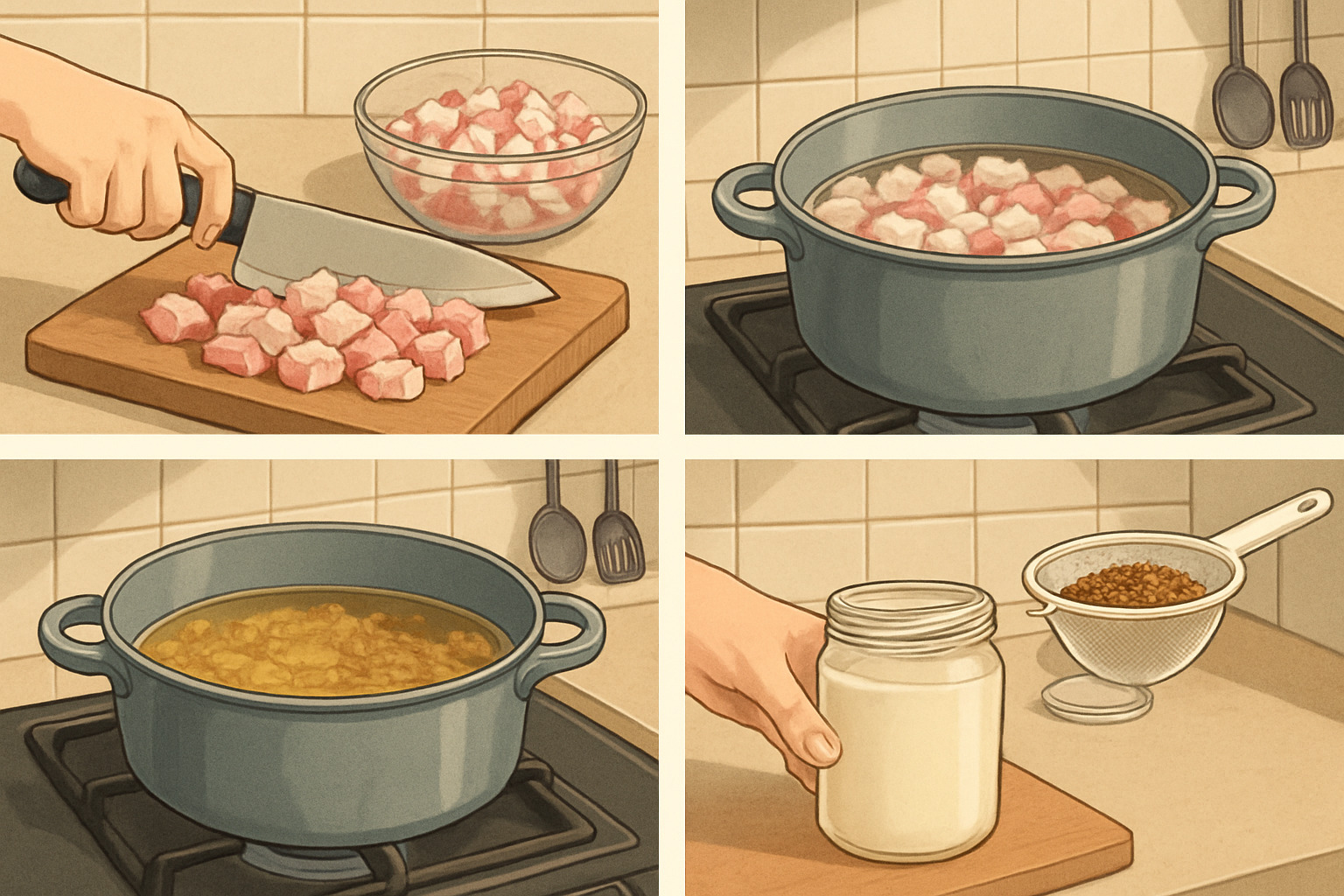
Traditional Rendering vs. Modern Purification
Traditional rendering focused on low-heat, slow cooking methods that preserved the fat’s natural structure and precious nutrients. Think of it like slow-cooking a stew – patience creates better results.
Modern commercial processing often rushes things with higher temperatures and chemical solvents. While faster, this approach can strip away the beneficial compounds that make tallow so valuable for skin health.
The best tallow for skincare uses gentle, low-heat methods that preserve natural vitamin content and fatty acid profiles. Many artisanal producers use triple-rendering – cooking the fat multiple times with salt water to remove impurities. This deodorizing process creates an odorless, pure white product that’s perfect for skincare.
Grass-fed sourcing isn’t just a trendy label – it makes a real difference. Grass-fed tallow contains four times more vitamin E than grain-fed tallow and up to 500% higher levels of conjugated linoleic acid (CLA), according to USDA research. That improved nutrient profile translates directly to better benefits for your skin.
Nutrient Snapshot: Vitamins & Fatty Acids Inside Tallow
What makes beef tallow for skin so special isn’t just its texture – it’s the impressive nutrient profile hiding inside that creamy white fat. Think of tallow as nature’s multivitamin for your skin, packed with compounds that work together to nourish and protect.
The fat-soluble vitamins in tallow are particularly exciting because they can actually penetrate your skin barrier. Vitamin A acts like a gentle renewal agent, encouraging healthy cell turnover without the irritation you might get from synthetic retinoids. Vitamin D steps in to support your skin’s natural immune function, while Vitamin E works overtime as an antioxidant bodyguard against environmental damage.
But here’s where it gets really interesting – tallow also contains Vitamin K for wound healing and Vitamin B12 to keep your skin cells functioning at their best. It’s like having a skincare pharmacy in one simple ingredient.
The fatty acid composition is where tallow really shines. Oleic acid makes up about 47% of tallow’s profile, providing that deep moisturizing power that penetrates beyond the surface. Palmitic acid (26%) and stearic acid work together to strengthen your skin’s protective barrier, while the rare palmitoleic acid supports skin regeneration.
Perhaps most impressive is tallow’s conjugated linoleic acid (CLA) content – a powerful anti-inflammatory compound that’s especially high in grass-fed sources. Some studies suggest CLA may help calm irritated skin and support healthy aging.
The real magic happens because tallow’s fatty acid profile mirrors human sebum so closely. This biocompatibility explains why many people find it absorbs quickly without that heavy, greasy feeling. Scientific research on tallow biocompatibility confirms that tallow’s lipid structure matches our skin’s natural barrier lipids remarkably well.
It’s this perfect nutritional storm – vitamins, fatty acids, and biocompatibility – that makes beef tallow for skin such a compelling choice for natural skincare enthusiasts.
Beef Tallow for Skin Benefits & Drawbacks
Let’s get real about what beef tallow for skin can actually do for you. While it’s having a major moment on social media, it’s important to understand both the genuine benefits and the potential downsides before you jump on this trend.
The science behind tallow’s effectiveness lies in its skin-identical lipids. Your skin naturally produces sebum with a similar fatty acid profile, which explains why many people find tallow absorbs beautifully without that heavy, greasy feeling you might expect from animal fat.
The barrier repair properties are where tallow really shines. When your skin barrier is compromised – whether from harsh weather, over-exfoliation, or skin conditions like eczema – tallow’s palmitic and stearic acids help restore that protective layer. This leads to deep moisturization that lasts much longer than typical water-based moisturizers.
Those fat-soluble antioxidant vitamins (A, D, E, and K) provide additional skin benefits beyond just hydration. Vitamin A supports cell turnover, while vitamin E protects against environmental damage. The anti-inflammatory CLA (conjugated linoleic acid) can help calm irritated skin, making tallow particularly appealing for those dealing with chronic dryness or sensitivity.
But here’s where we need to pump the brakes a bit. Tallow has a comedogenic rating of 2-3, meaning it can potentially clog pores for some people. If you’re already dealing with acne or blackheads, this might not be your best bet. Additionally, even well-rendered tallow can have odor concerns – that slight meaty scent isn’t everyone’s cup of tea.
Why People Use Beef Tallow for Skin Hydration
The main reason people are raving about tallow is its incredible ability to create a protective emollient layer on your skin. Unlike lotions that can evaporate within hours, tallow forms a semi-occlusive barrier that locks moisture in for the long haul.
Many users report remarkable success with stubborn conditions. People struggling with eczema relief often find that tallow helps reduce flare-ups and decreases their dependence on prescription creams. Winter dryness – you know, that tight, uncomfortable feeling when the heating kicks in – seems to meet its match with tallow’s intensive moisturizing power.
The anecdotal reviews are pretty compelling too. Customer feedback for tallow-based products consistently shows ratings around 4.5 out of 5 stars, with 76% of users giving full 5-star ratings. People consistently praise how it transforms dry, cracked skin and how surprisingly well it absorbs despite being an animal fat.
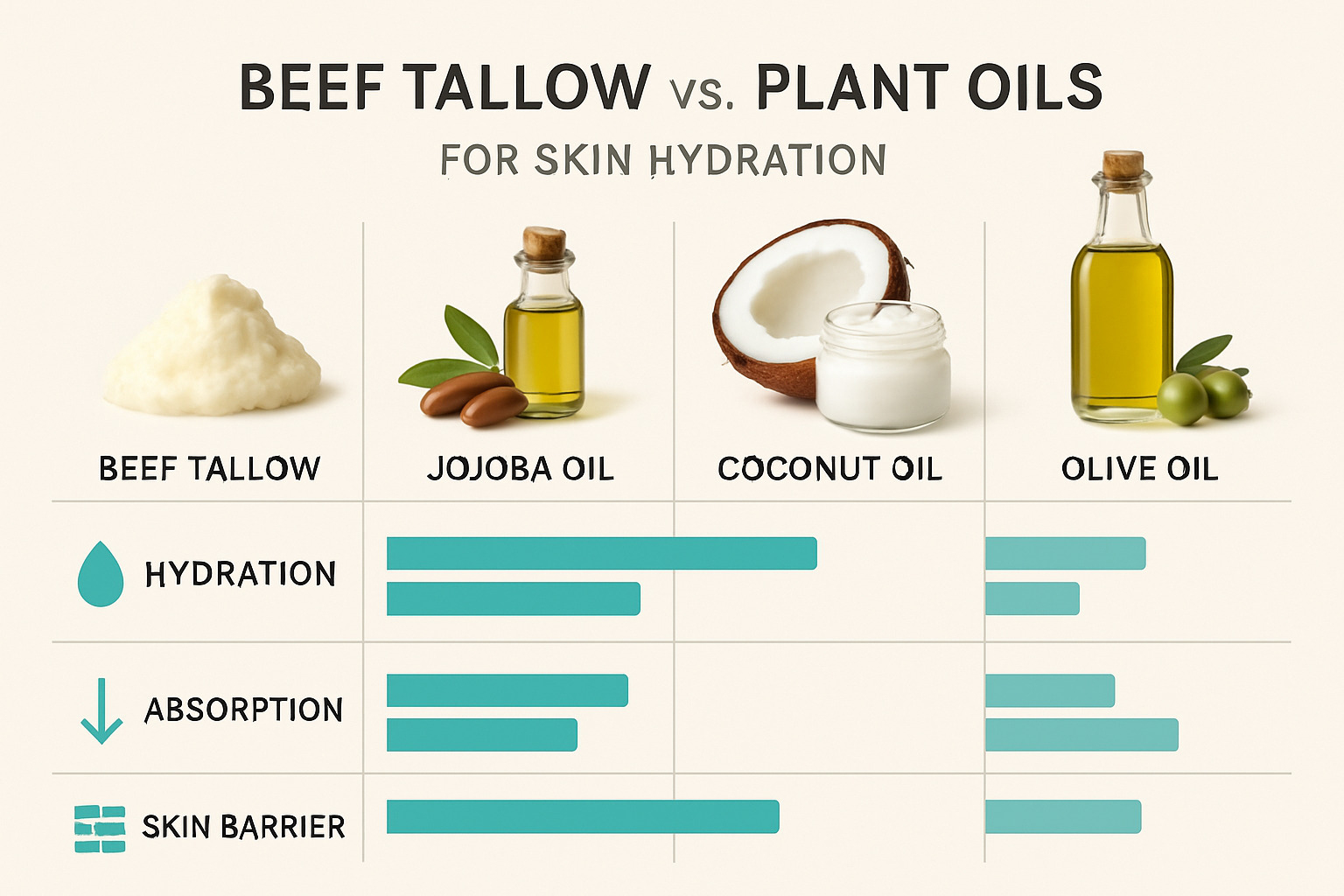
Scientific Evidence Supporting Beef Tallow for Skin
While we’d love to see more human studies, the research we do have is genuinely promising. A 2024 scoping review examined 19 studies on tallow’s biocompatibility with skin and found some encouraging results that back up what people are experiencing firsthand.
The research showed that tallow-based emulsions improved symptoms in animal models of atopic dermatitis and psoriasis. Even more interesting, enzymatically modified tallow esters produced 47.2% greater skin hydration over 180 minutes compared to regular tallow – suggesting there’s still room for improvement in how we process this ingredient.
A small eczema trial from 2017 reported improved moisture levels in patients with eczema and psoriasis using tallow emulsions. While the sample size was small and we definitely need more research, it’s a promising start.
The vitamin absorption aspect is particularly intriguing. Because tallow contains fat-soluble vitamins in a form that’s naturally compatible with your skin, there’s potential for better absorption compared to synthetic alternatives. Scientific research on honey-tallow synergy suggests that combining tallow with other natural ingredients like honey may boost its therapeutic properties through complementary antimicrobial and wound-healing effects.
The bottom line? While the scientific research on tallow biocompatibility shows genuine promise, we’re still in the early stages of understanding exactly how and why beef tallow for skin works so well for many people.
Application Guide: Getting the Most from Tallow
Getting the most from beef tallow for skin isn’t complicated, but a few smart techniques can make all the difference between disappointing results and glowing skin.
Start with a patch test – this isn’t optional. Apply a small amount to your inner arm and wait 24 hours. Even though tallow is generally well-tolerated, everyone’s skin is different, and it’s better to be safe than sorry.
When you’re ready to dive in, less is definitely more. A pea-sized amount can cover your entire face, and using too much will leave you feeling greasy rather than glowing. The trick is to warm the tallow between your palms first – this softens it and makes application much smoother.
Timing matters tremendously. Your skin does most of its repair work at night, making tallow perfect as an overnight treatment. Apply it as your final skincare step on clean, slightly damp skin. The moisture helps the tallow spread more easily and creates better absorption.
Frequency is key to success. Start with once weekly applications and gradually increase if your skin responds well. Some people can use tallow nightly, while others find 2-3 times per week works better. Your skin will tell you what it prefers.
For easier application, try blending tallow with lighter oils like jojoba. This creates a more spreadable texture while maintaining the deep moisturizing benefits. A 70/30 tallow-to-oil ratio works well for most people.
Here’s how beef tallow for skin compares to plant oils: Absorption happens faster with tallow due to its skin-identical lipids, vitamin content includes fat-soluble vitamins A, D, E, and K that many plant oils lack, stability is superior with less risk of rancidity, though the comedogenic rating of 2-3 means it may clog pores more than some plant alternatives.
Best Practices for Different Skin Types
Dry skin absolutely loves tallow. If you’re dealing with flaky, tight, or irritated skin, apply tallow nightly to lock in moisture and repair your skin barrier. The rich fatty acid profile provides the deep, lasting hydration that dry skin craves.
Mature skin benefits tremendously from tallow’s anti-aging vitamins. Focus your application on areas with fine lines, age spots, or loss of firmness. The vitamin A supports cell turnover while vitamin E provides antioxidant protection.
Sensitive skin often responds beautifully to tallow’s anti-inflammatory properties. The CLA content can help calm irritation and redness. However, always patch test first and choose the purest, unscented tallow products you can find.
Acne-prone skin requires extra caution. While tallow has antimicrobial properties that could theoretically help with breakouts, its comedogenic rating means it might clog pores. Consider using it only on non-acne-prone areas like your neck or hands, or mix it with non-comedogenic oils to reduce the risk.
DIY vs. Ready-Made Products
Making your own tallow gives you complete control over quality and processing. Source suet from grass-fed cattle, use low-heat wet rendering, and triple-render for the purest results. The downside? It’s time-consuming and requires proper technique to avoid bacterial contamination.
Ready-made products offer convenience and consistent quality without the hassle. Look for products that specify grass-fed sourcing, minimal ingredients, and proper rendering methods. Avoid anything with synthetic preservatives or fragrances that could irritate your skin.
Quality checks apply to both options. Good tallow should be creamy white (not yellow or gray), have minimal odor, and feel firm but melt easily when warmed. Any signs of rancidity like off smells or discoloration mean it’s time to toss it and start fresh.
Safety, Ethics & Smart Buying
When considering beef tallow for skin, it’s important to think beyond just the skincare benefits. Like any ingredient, tallow comes with considerations that might affect whether it’s right for you.
Safety should always come first. If you have a beef protein allergy, tallow is an absolute no-go. Even though the rendering process removes most proteins, trace amounts can still trigger reactions. Similarly, anyone with very oily or acne-prone skin should proceed with caution, as tallow’s comedogenic rating means it could worsen breakouts.
Some users report increased sun sensitivity when using tallow, though this isn’t scientifically confirmed. What we do know is that patch testing is non-negotiable – apply a small amount to your inner arm and wait 24 hours before using it on your face.
Here’s something many people don’t realize: beef tallow isn’t regulated by the FDA for cosmetic use. There are no established safety standards or quality requirements, which makes your sourcing decisions incredibly important. Poor-quality or improperly rendered tallow can harbor bacteria or contain harmful contaminants.
Grass-fed certification matters more than you might think. Grass-fed cattle produce tallow with significantly higher levels of beneficial compounds like vitamin E and CLA. Look for transparent sourcing information – if a company won’t tell you where their tallow comes from, that’s a red flag.
When shopping, avoid products with lengthy ingredient lists. The best tallow products are simple: rendered tallow, maybe a complementary oil like jojoba, and that’s it. Synthetic preservatives and fragrances defeat the purpose of choosing a natural product.
The ethics angle is personal but worth considering. While tallow uses a byproduct of meat production (supporting the nose-to-tail philosophy), some people prefer to avoid animal-derived skincare entirely. There’s no right or wrong answer here – it’s about what aligns with your values.
For more guidance on evaluating skincare ingredients and making informed choices, check out our resource on Learning About Skincare Ingredients.
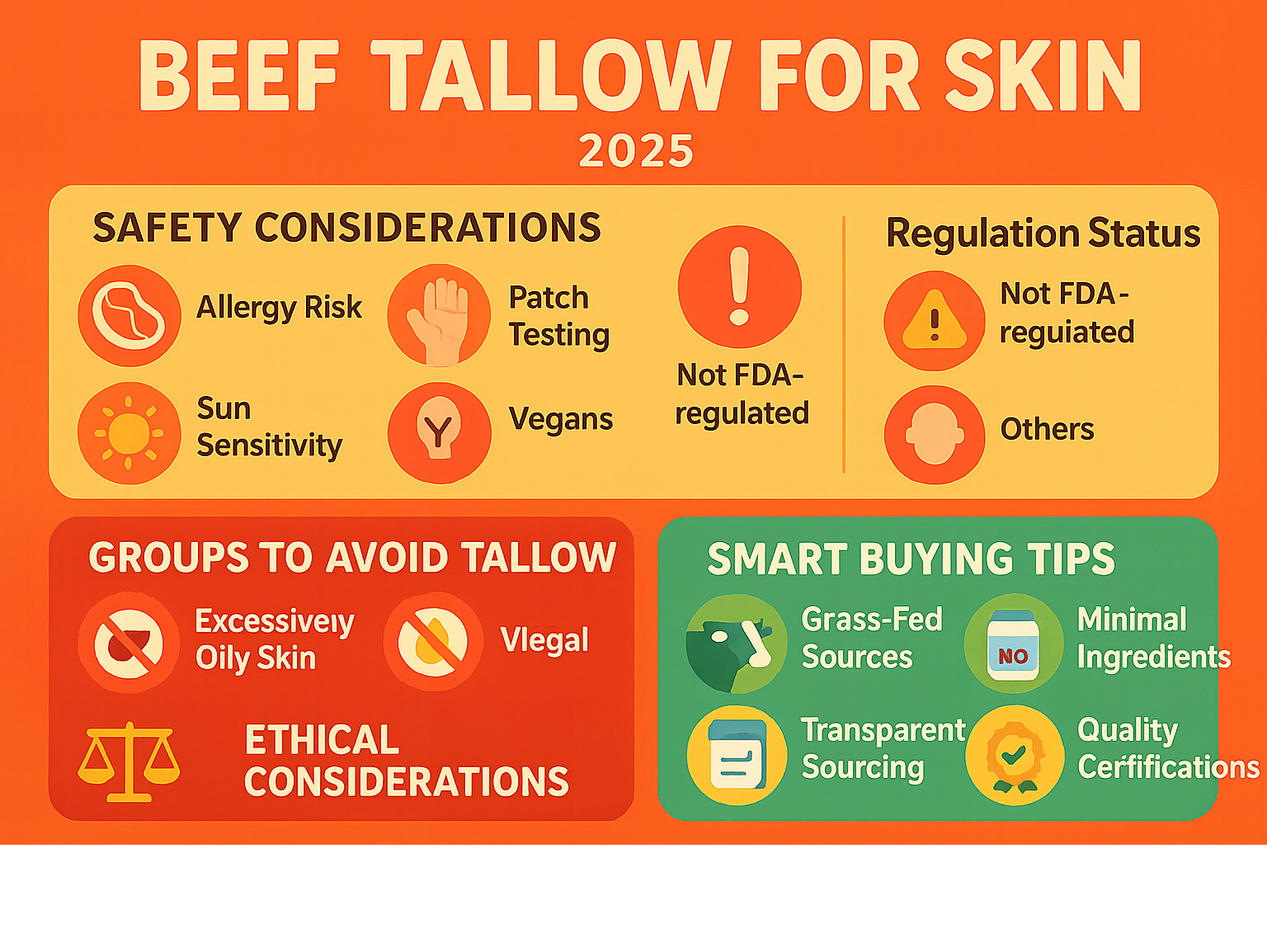
Alternatives & Complementary Natural Moisturizers
Let’s be real – beef tallow for skin isn’t everyone’s cup of tea. Whether you’re vegan, dealing with acne-prone skin, or just want to explore other options, there are plenty of natural moisturizers that can give you similar benefits.
Shea butter is probably the closest plant-based alternative to tallow. It’s rich in vitamins A and E, has anti-inflammatory properties, and provides that same deep moisturizing power that makes tallow so popular. Plus, it doesn’t have any of the ethical concerns that come with animal-derived products.
If you’re looking for something lighter, squalane is a game-changer. This lightweight oil mimics your skin’s natural sebum without clogging pores, making it perfect for people who want hydration without the heaviness. It’s derived from olives or sugarcane, so it’s completely plant-based.
Jojoba oil is technically a wax (just like tallow becomes waxy when cool), and it’s incredibly similar to human sebum. Many people find it absorbs beautifully and doesn’t leave that greasy feeling some oils can cause.
For those seeking anti-aging benefits similar to tallow’s vitamin content, argan oil delivers vitamin E and essential fatty acids that support skin repair and elasticity.
Don’t overlook humectant options like hyaluronic acid and glycerin. While they work differently than tallow (drawing moisture from the environment rather than creating a protective barrier), they can be incredibly effective for maintaining hydration.
Here’s where it gets interesting – many people find that blending tallow with lighter oils gives them the best of both worlds. A 1:1 ratio of tallow and jojoba oil reduces greasiness while maintaining the deep moisturizing benefits. Tallow mixed with squalane works beautifully for sensitive skin, while combining it with argan oil can boost anti-aging effects.
If you’re moving away from tallow entirely, ceramide-rich moisturizers offer synthetic versions of your skin’s natural barrier lipids. They’re not natural, but they’re incredibly effective at repairing damaged skin barriers.
The truth is, there’s no perfect moisturizer for everyone. Some people swear by beef tallow for skin, while others find their holy grail in plant-based alternatives. The key is experimenting (safely, with patch tests) to find what makes your skin happiest.
For more natural skincare options, explore our guide to Natural Skincare Solutions.
Frequently Asked Questions about Beef Tallow for Skin
Is beef tallow suitable for acne-prone skin?
This is probably the most common question we get about beef tallow for skin, and honestly, it’s complicated. Beef tallow has a comedogenic rating of 2-3 on a scale of 0-5, which means it has a moderate chance of clogging pores.
Here’s the thing though – tallow contains natural antimicrobial compounds that could theoretically help fight acne-causing bacteria. But most dermatologists still don’t recommend it for people with oily or acne-prone skin because the risk of clogged pores often outweighs the potential benefits.
If you’re determined to try tallow despite having acne-prone skin, we’d suggest being really strategic about it. Start by using it only on areas that don’t typically break out – maybe just your cheeks if your T-zone is problematic. You could also try mixing it with non-comedogenic oils like jojoba to lighten the texture.
Begin with tiny amounts once a week and watch your skin carefully. If you notice any increase in breakouts, it’s time to stop. Your skin will tell you pretty quickly if tallow isn’t a good fit.
Will tallow clog my pores or feel greasy?
Most people are surprised by how well pure, properly rendered tallow absorbs into skin. When you use the right amount – we’re talking pea-sized for your entire face – it typically melts in without leaving that heavy, greasy feeling you might expect from animal fat.
The secret is in the technique. Always warm the tallow between your palms first to soften it before applying. This makes it spread more easily and absorb better. Think of it like butter – it goes on much smoother when it’s slightly warmed.
That said, your experience really depends on a few factors. If you apply too much product, have naturally oily skin, or use poorly rendered tallow with impurities, you’re more likely to experience that greasy feeling. Some people also find it too heavy when layered over other products.
If tallow feels too rich for you, try mixing it with lighter oils or save it for nighttime use only. Your skin tends to be more receptive to heavier products while you sleep.
How long does rendered tallow last on the shelf?
Good news here – properly rendered beef tallow is surprisingly shelf-stable. You can expect it to last 12-18 months at room temperature, or up to 2 years when refrigerated. This makes it more stable than many plant oils that can go rancid quickly.
You’ll know your tallow has gone bad when it develops rancid or off odors, changes color (usually yellowing or darkening), or develops unusual texture changes. If you ever see mold growth, that usually means moisture got introduced somehow.
To get the maximum shelf life from your tallow, store it in airtight containers away from light and heat. Always use clean, dry utensils when scooping – introducing water or bacteria can shorten its lifespan significantly. If you live in a hot climate, consider keeping it in the refrigerator.
One clever trick is to freeze portions of tallow for extended storage. This way, you can keep a small amount accessible for daily use while preserving the rest for later.
Conclusion
After diving deep into beef tallow for skin, it’s clear this isn’t just another fleeting TikTok trend. There’s genuine science behind why this ancestral practice is making a comeback in modern skincare routines.
The truth is, beef tallow for skin offers some impressive benefits – but it’s not right for everyone. The research shows it can be a game-changer for people with dry, mature, or sensitive skin who need serious barrier repair and deep hydration. Those fat-soluble vitamins and skin-identical fatty acids really do make a difference.
But let’s be honest about the limitations too. If you’re dealing with acne-prone skin, this probably isn’t your best bet. And if you’re committed to plant-based beauty, there are excellent alternatives that can deliver similar results.
From a clean beauty perspective, tallow represents everything we love about minimalist skincare – one simple ingredient that your great-grandmother would recognize. No mysterious chemical names, no lengthy ingredient lists, just pure rendered fat that’s been nourishing skin for centuries.
The key is making an informed choice that aligns with both your skin’s needs and your personal values. Quality matters enormously here – grass-fed, properly rendered tallow is worlds apart from poorly processed alternatives.
At Beyond Beauty Lab, we’re passionate about helping you steer these choices with confidence. Whether beef tallow for skin becomes your holy grail moisturizer or you prefer exploring plant-based options, understanding the science empowers you to make better decisions.
Ready to explore more clean beauty wisdom? Our comprehensive guide to Clean Beauty Skincare offers evidence-based recommendations that help you build a routine that truly works for your unique skin and lifestyle.
The best skincare routine isn’t about following trends – it’s about finding what genuinely works for your skin, fits seamlessly into your life, and feels good to use every day. Beef tallow for skin might be that perfect solution for some, but it’s just one beautiful option in the rich world of natural skincare.

